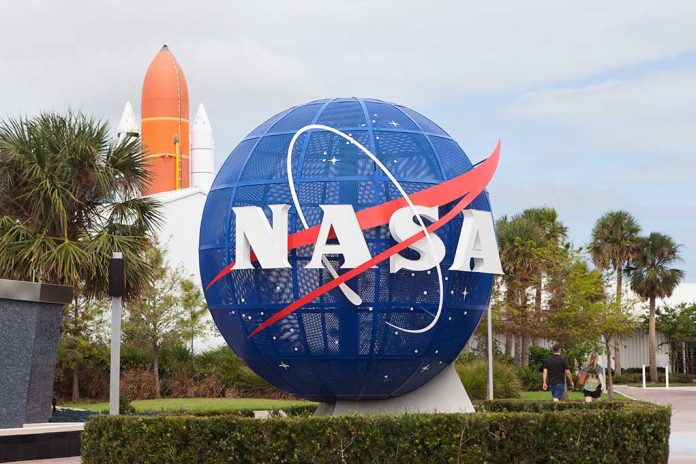
President Trump’s $6 billion NASA budget cut strategically redirects American space exploration away from wasteful climate programs and towards the Moon and Mars, eliminating bureaucratic inefficiencies while empowering private companies like SpaceX to lead the charge.
Key Takeaways
- The proposed 24.3% reduction slashes NASA’s budget from $24.8 billion to $18.8 billion for FY2026, prioritizing lunar and Mars exploration while cutting climate research
- NASA officials view the budget constraint as an opportunity to reduce bureaucracy and refocus on core missions rather than a setback
- The Space Launch System (SLS) and Orion spacecraft will be phased out after three flights, with commercial alternatives expected to provide more cost-effective solutions
- Climate-focused satellite programs and the over-budget Mars Sample Return mission will be eliminated to streamline operations
- The cuts position private sector companies like SpaceX and Blue Origin to play expanded roles in America’s renewed space exploration efforts
Streamlining NASA for Mission Success
The White House has proposed a substantial 24.3% cut to NASA’s budget for Fiscal Year 2026, reducing it from $24.8 billion to $18.8 billion. Despite concerns from critics, senior NASA officials view this realignment as a strategic opportunity to enhance efficiency and focus on core exploration priorities. The budget maintains over $7 billion for lunar exploration programs and allocates $1 billion specifically for Mars-focused initiatives, ensuring America’s continued leadership in space exploration while eliminating wasteful spending on peripheral projects that have consistently faced delays and cost overruns.
“The reductions in the President’s blueprint budget counterintuitively represent an opportunity to truly innovate in how we conduct our space missions,” said Ryan Whitley, senior NASA official.
President Trump’s budget proposes ending financially unsustainable programs like the Mars Sample Return mission, which has faced significant cost overruns, and eliminating low-priority climate monitoring satellites. The administration argues these cuts are necessary to refocus NASA on its original mission of exploration rather than politicized climate research. The International Space Station program would also see a reduction of over $500 million, with plans to transition to commercial space stations by 2030, further leveraging private sector innovation while reducing taxpayer burden.
Reimagining Lunar Exploration
The budget calls for significant changes to the Artemis program, which was initially launched during President Trump’s first term. Under the new plan, the expensive Space Launch System (SLS) and Orion spacecraft would be phased out after three flights, and the Moon-orbiting Gateway mini-space station would be canceled. These elements have repeatedly faced delays and ballooning costs, with minimal progress to show for billions in taxpayer spending. Instead, the budget proposes transitioning to more economical commercial systems for lunar exploration, which have proven more effective and cost-efficient.
— S.E. Robinson, Jr. (@SERobinsonJr) May 2, 2025
“Now is the time to reduce the bureaucracy at NASA and turn our attention to the execution of bold new human missions to the Moon and Mars,” said Ryan Whitley, senior NASA official.
The Gateway Program will end completely, though some components may be repurposed for other missions. International partners previously involved with Gateway will be invited to collaborate on alternative lunar exploration initiatives that deliver more tangible results. This approach aligns with the administration’s commitment to minimize duplication of efforts and allocate taxpayer dollars more efficiently, ensuring that America’s space program remains focused on achievable goals rather than perpetually delayed projects that drain resources without delivering results.
Private Sector Partnership and Competition with China
A core element of the budget strategy involves increasing collaboration with private aerospace companies like SpaceX and Blue Origin. These firms have demonstrated their ability to deliver innovative solutions at a fraction of the cost of traditional government programs. By reducing NASA’s bureaucracy and empowering these private partners, the administration believes it can accelerate progress toward both lunar and Mars exploration goals while remaining fiscally responsible. This approach represents a fundamental shift from the agency’s traditional cost-plus contracting model toward fixed-price commercial partnerships.
The budget reorientation also serves America’s strategic interests by ensuring the United States does not fall behind China’s rapidly advancing space program. By focusing resources on high-priority lunar missions rather than spreading funding across numerous smaller initiatives, NASA can maintain American leadership in space. The cuts to climate-focused spending and diversity initiatives also reflect the administration’s commitment to refocusing the agency on its core exploration mission rather than social programs that dilute its effectiveness and purpose while adding bureaucratic complexity.
Congressional Review and Implementation
While the budget proposal has generated criticism from some lawmakers and organizations concerned about its impact on specific programs, it represents a bold vision for reforming an agency that has struggled with project delays and cost overruns for decades. The proposal will require congressional approval, giving legislators the opportunity to weigh in on these priorities. However, NASA leadership has expressed confidence that the new approach will ultimately enhance innovation and exploration capabilities while providing better value for taxpayers.
“This proposal includes investments to simultaneously pursue exploration of the Moon and Mars while still prioritizing critical science and technology research,” said acting NASA Administrator Janet Petro.
With the budget’s emphasis on streamlining operations and leveraging commercial partnerships, NASA appears poised to enter a new era focused on exploration rather than bureaucracy. By eliminating wasteful climate programs and redirecting those resources toward tangible achievements in space, the Trump administration aims to restore NASA’s original mission focus while ensuring American leadership in the increasingly competitive domain of space exploration. The budget cuts, far from hampering progress, may well accelerate America’s return to the Moon and eventual journey to Mars by forcing long-overdue reforms.













